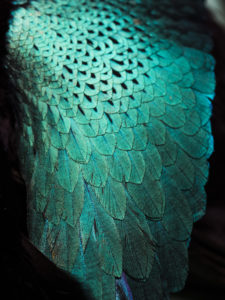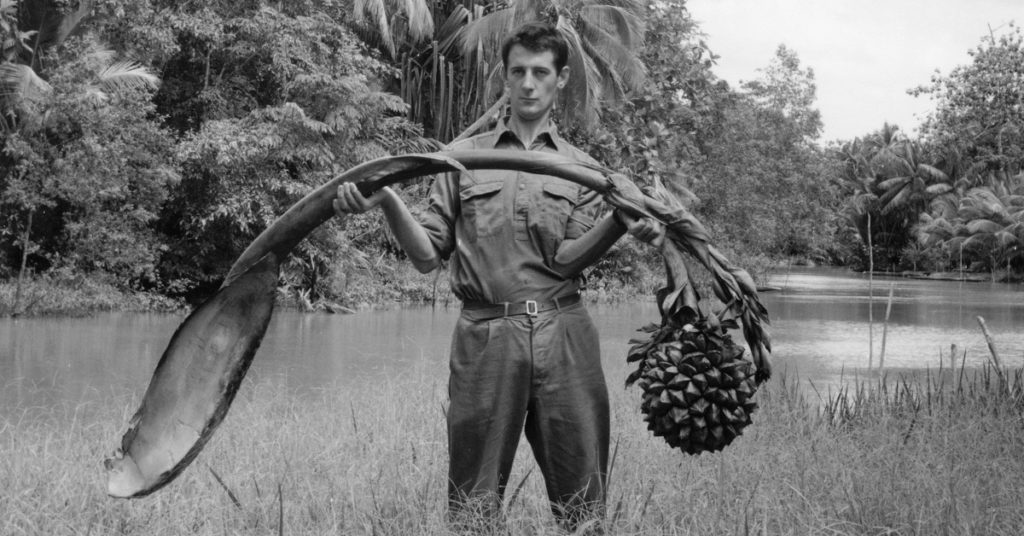Kokoda is a global hotspot for biodiversity, and the specimens housed at Canberra's The Australian National Herbarium are vital for understanding such diversity.
CSIRO botanist Lyn Craven (1945 – 2014) holding a fruiting stalk of a nipa palm (Nypa fruticans), near Ravikivau, Purari River delta, Papua New Guinea, 19 Feb. 1966 (Photographer: Dick Schodde). That fruiting stalk was subsequently preserved as a specimen in the Australian National Herbarium.
Kokoda has become a site of pilgrimage for many Australians, a place to experience the history of World War II. The area is also a global hotspot for biodiversity.
The Kokoda Track and Owen Stanley Ranges were included in CSIRO’s land-use surveys in Papua New Guinea during the 1950s and 1960s. The plant and animal specimens collected there have since been housed in Canberra. The Australian National Herbarium in Canberra is home to more than 200,000 plant specimens from PNG.
“These specimens are vital for understanding PNG’s biodiversity, but the information wasn’t readily accessible,” says Brendan Lepschi, who works at the Herbarium.
“We’ve now delivered a trove of specimen data to the people of PNG, to help manage conservation and tourism in the Kokoda area,” he says.

Feathers from the Superb Bird of Paradise (Lophorina superb). A unique and ornate native to PNG.
Herbarium staff trawled through the PNG collection, making sure specimens were correctly identified and then capturing detailed information on name, collection date, location, altitude, habitat and more in the Herbarium’s electronic specimen database.
“We began with the Ericaceae, a group that includes showy plants like rhododendrons and is richly represented in the Kokoda area,” says Mr Lepschi.
“We then added information on birds, mammals, reptiles and amphibians from the Australian National Wildlife Collection, as well as butterflies, dragonflies and beetles from the Australian National Insect Collection.
“We’d like to continue by adding other plant groups, including ferns, figs and umbrella trees,” he says.
Brendan says that there are special challenges in working with the Herbarium’s PNG collection. The plants are less well known to staff here than Australian plants. Many species are undescribed and specimens are often fragile due to having large, soft leaves that become crisp and brittle when dry.
“Biological collections from 50 or 60 years ago tend to have less label data, including quite important things like latitude and longitude,” says Brendan. “Identifying exactly where a plant was collected can also be difficult due to the complex and changing geography of PNG villages.”
This work was funded by the Australian Department of the Environment to validate and provide biological collection data to the PNG Department of Environment and Conservation for inclusion in the PNG National Biodiversity Information System.
The Australian National Herbarium is part of the Centre for Australian National Biodiversity Research, a joint venture between Parks Australia’s Australian National Botanic Gardens and CSIRO.
You are welcome to reprint this article; please contact the author first.



29th April 2016 at 10:22 am
Good work, I hope it leads to a trekkers’ guide to the remarkable vegetation and fauna of the Kokoda Track : the butterfly-rich creeks and rivers; the lowland, mid-montane and cloudy montane forests; the garden clearings. All the trekking companies focus on the military history and seem to ignore the natural history. When I walked the track in 2008 I pointed out a bunch of cluster figs on a tree trunk. Our guide said she had thought they were figs, but one of her previous walkers had been adamant that there were no figs in PNG. I later sent her the list of NG Ficus – about 60 species!
The guide will have to describe what you can see underfoot, you can’t wander along gazing into the canopy. Quercus acorns, Nothofagus beech, fallen fruit, flowers, coloured deciduous leaves, brilliant fungi… I first walked part of it in early 1970s as the Sogeri patrol officer, took the first photos of the bower of the striped bower bird and saw the blue bird of paradise at Mt Maguli where Hunstein collected the type specimens in the 1880s. Such rich and rewarding ‘secrets’ need to be shouted from the mountain tops and the Koiari people supported to keep the forests intact.